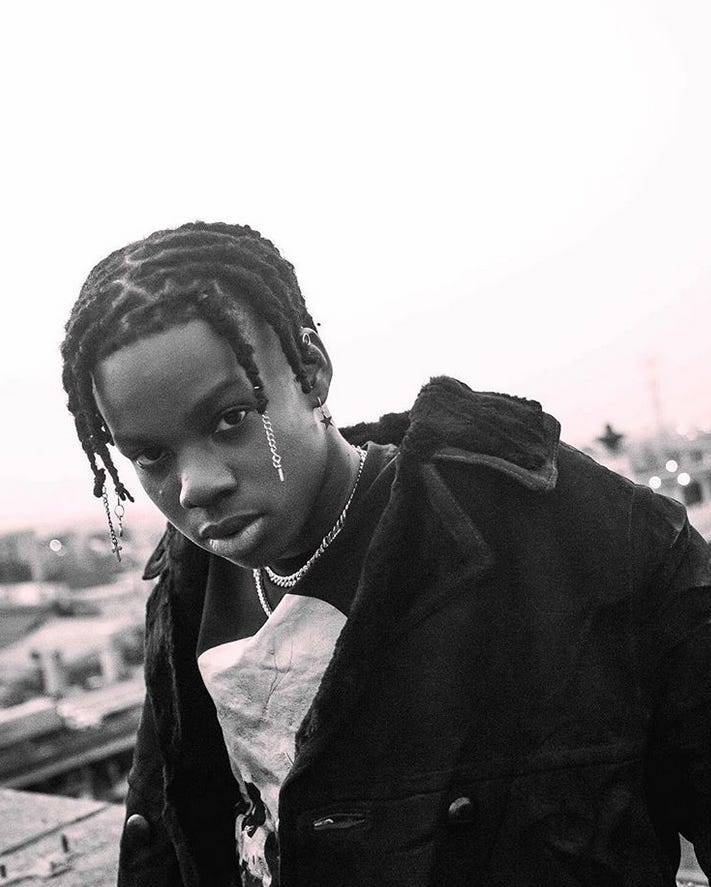One picture can tell you everything about an artist. I was scrolling on X the other day when I saw a post from heisremanewss. They did what every fan account does—post pictures of their fav to keep fellow fans updated and in the hopes that non-fans will see the pictures and feel the unmistakable desire to become a fan or at least talk about the celebrity for a while. Well, their plan worked cause immediately I saw it, I was reminded of a myriad of other pictures and videos of Rema that I had seen over the past year and something immediately stood out—the unmistakable femininity that Rema exudes in his photo-ops.
The photos in question were from Rema’s current cover shoot for DAZED.
Fans and non-fans alike often talk about how the Nigerian artist’s sound has changed drastically, debating whether or not it’s for the good of his discography. But something else that has changed, ever so slightly, is Rema’s branding and marketing over the past year since the release of HEIS.
Rema’s First Stint in the Market
Rema, whose real name is Divine Ikubor, is a Nigerian singer and songwriter. At just 24 years old, Rema is known as a staple voice in Afrobeats securing global awards including an MTV Europe Music Award and a number 3 spot on the Billboard Hot 100 for his single with Selena Gomez, ‘Calm Down’. But beyond the numbers, what has always endeared fans to Rema is his music, even when it changes. Rema has boldly remarked that he’s part of the Big 4, playing on the Big 3 narrative in Nigerian music by associating himself with other male artists who are considered the biggest names in the genre (Wizkid, Burna Boy and Davido). But unlike the other ‘Big 4’, Rema stands out not just for producing versatile sounds but for switching up his branding and image to match each release.
Rema first went viral on the Nigerian scene with his debut single, ‘Dumebi’ in 2019. The sound was fun, upbeat and very afro with repetitive lyrics, unstructured storytelling and an addictive beat. It was a hit instantly. But more than the song was the messaging around the release. Rema was a teenager when ‘Dumebi’ was released and his agency, Mavin, kept that in mind throughout the rollout and promotions. From the song lyrics to the documentary-style music video plus the layered outfits popularized in the 2020s, the release felt like the first release of an up and coming teenage star—which is exactly what it was and why it resonated with so many people.
Across Twitter (when it was still Twitter), Nigerians commented about how ‘refreshing’ the production was from the sound to featuring other young people who would, as of now, become recognizable names in Nigerian pop culture such as Amy Okoli. The trend continued on for his first EP, ‘Rema’, where he released other upbeat and Afrobeats heavy songs like ‘Iron Man’, and in the following year, 2020, when he released other singles like ‘Lady’, ‘Bad Commando’, and ‘Beamer’. The singles’ artworks were animated with bright colors and abstract imagery while his clothes remained simple, understated and ultimately teenage. Styled by the likes of Daniel Adetota, Rema wore dark colors, layers of jackets, vests and graphic t-shirts.
Entering Adulthood
The first major shift happened in 2021 with the release of ‘Bounce’. Rema had turned 21 and was officially considered an adult in every country worldwide. With that came a new sound and of course, a new look. While in ‘Dumebi’ Rema focused on the feeling of having a crush, ‘Bounce’ was Rema simply describing himself in lust, tapping in fully to the suggestive energy we could feel and hear in his previous songs like ‘Iron Man’. After ‘Bounce’ came more sexually charged lyrics on a strong sultry beat in ‘Soundgasm’ in 2022 from his debut studio album, Raves and Roses.
Raves and Roses was not an extension of Rema’s established sound but rather a completion of it and an introduction to something new. His sound remained fun, like a night out, with a progression of drums, bass and sax. It was heavily Afro with sounds that make you see and feel rather than just hear. In 2022, Rema also had a Rolling Stone UK cover issue where he was styled by Joseph Kocharian. The cover presented a Rema who was now firmly stepping into a bolder, more mature aesthetic. His choices in fashion and overall branding suggested that he was no longer just an emerging talent but a global artist unafraid to experiment with sound and aesthetic.
The Power of Posing
For his British GQ cover, his color palette is neutral. While he still adorns heavy chains, tank tops with unique designs and vests, the styling and creative direction of the cover differs from what we once knew. Still, more than that is his posing.
His body language in photoshoots, performances, and album art consistently leans toward feminine-coded gestures: soft shoulders, relaxed wrists, tilted heads, and poised, almost delicate stances. This isn’t incidental. The way he holds himself in images is just as important as what he wears, shaping how his audience interprets him. A report on the Asia Marketing Journal on posing and consumer perception explains this in detail. Rema’s poses send specific signals about his power, accessibility, and desirability, consciously or unconsciously influencing how his audience relates to him.
Dominant poses (expansive, open, assertive stances) communicate power, status, and exclusivity, often making the subject appear more distant and untouchable. This is why traditional male artists—especially in Afrobeats—often pose with wide stances, squared shoulders, or direct, assertive eye contact. Their presence is meant to command rather than invite. Rema, however, frequently adopts submissive or feminine-coded poses—tilting his head, slightly curving his posture, or positioning his hands in a delicate manner. According to the study, these softer poses create a perception of approachability, warmth, and intimacy. Instead of exuding dominance or untouchable power, he appears inviting, relatable, and emotionally expressive.
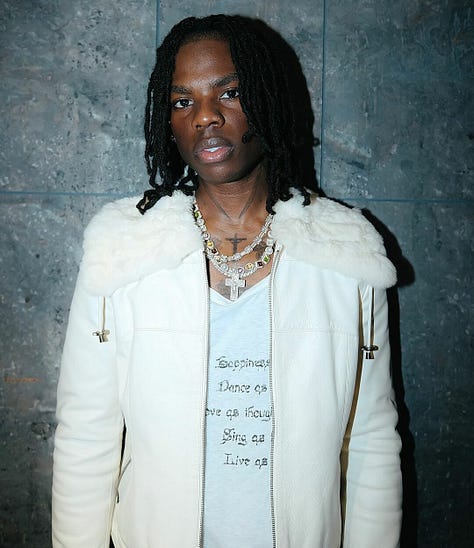


For female audiences, who make up a significant portion of Rema’s fanbase, this kind of body language can increase emotional connection. Rather than being a distant, hyper-masculine figure, Rema’s posing makes him seem more intimate and emotionally accessible, subtly reinforcing the idea that he is someone to be admired and desired, but also understood and felt.
Styling the Big 4
Rema’s branding evolution also differs significantly from the branding shifts of Wizkid, Burna Boy, and Davido. While these three artists have all evolved over time, their transformations have either been largely tied to their musical reinvention or completely separate from it as a reference to their personal lives. Wizkid’s Made in Lagos era positioned him as a global icon and like his sound, his fashion became softer, understated, and clean. Burna Boy’s Grammy win coincided with a transition into a more tailored look, like combining Fela and Elvis, then adapting them for the 2020s. Davido’s branding has shifted from hitmaker to family man to label executive all while still wearing the same puffer jackets and t-shirts for years. In contrast, Rema’s transformation isn’t solely dictated by his music, it’s a reflection of his personal evolution and growth. Still, he doesn’t evolve in a vacuum but takes his fashion and styling with him.
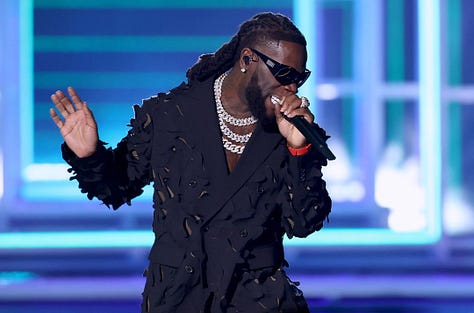
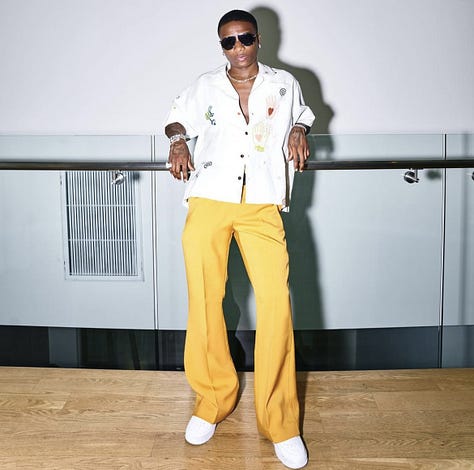
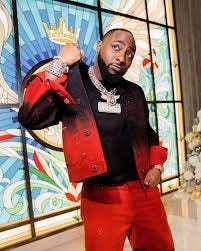
This distinction makes his artistic journey feel more organic. Fans are not just witnessing a calculated rebrand for an album cycle (or at least it doesn’t feel like it); they are watching him grow and age in real time. His aesthetic choices feel authentic because they stem from his identity rather than external market expectations.
Contradictions in Sound and Style
Rema’s visual evolution is striking, but what makes it even more intriguing is how it contrasts his lyrics. While his fashion choices sometimes blur gender lines—featuring tank tops, sheer fabrics, and delicate jewelry—his lyrics remain assertively masculine, often exuding confidence, dominance, and sensuality.
Take, for instance, his breakout hit ‘Dumebi’. The song is playful, lighthearted, and centered around youthful infatuation. The visuals matched the sound—colorful, casual, and reflective of a teenage romance. But fast forward to ‘Bounce’ and ‘Soundgasm,’ and Rema’s lyrical approach shifts. ‘Bounce’ is brazenly sexual:
Girl, I'm never kiddin', wanna put it in your splin'
This one wey you shakin' no be China thing
Similarly, ‘Soundgasm’ thrives on sensuality:
She dey give me eye contact
Oh baby, j'kako, ah
The lyrical themes in HEIS, his latest album, further emphasize desire, hedonism, and self-assured bravado. In ‘DND’, he raps:
Money full my mind, I no dey hear word
These are lyrics that, on paper, align more closely with the hyper-masculine branding of Afrobeats’ biggest stars. Yet, visually, Rema is rejecting some of the traditional markers of masculinity that typically accompany such themes.
The Divine Feminine
American hip hop has had a significant impact on global pop culture, but it is most appreciated for its contributions to music and fashion. Narrowing in on fashion, faces such as Prince, Virgil Abloh, Lil Kim, Kanye West and Rihanna were integral in pushing the fashion of hip hop to mainstream success from establishing baggy jeans as an outfit staple to the proliferation of denim, the introduction of layered jackets, and an appreciation of diamond chains and accessories. Blending these worlds, they’ve created a form of ‘high fashion street fashion’ that introduces high art themes in film, art and music, reproducing them in designs that resonate with what we know as street style. I see these inspirations clearly in Rema’s looks from 2021-2023.
Someone who particularly stands out to me in establishing and popularizing a new form of hip hop fashion that Rema seems to be tapping into is Young Thug. Young Thug is an American rapper known for his daring fashion choices that accentuate his masculinity by embracing gender fluidity and non-conformity. Refusing to conform to hip-hop’s hyper-masculine aesthetic, he wore dresses, painted his nails, and adorned himself with accessories that were traditionally seen as feminine. His style wasn’t just about looking good; it was about disrupting expectations.
Similarly, Rema follows in the footsteps of artists like Prince, who redefined Black male sexuality with his high heels, lace, and bold, gender-fluid fashion, all while delivering lyrics dripping with desire and power.
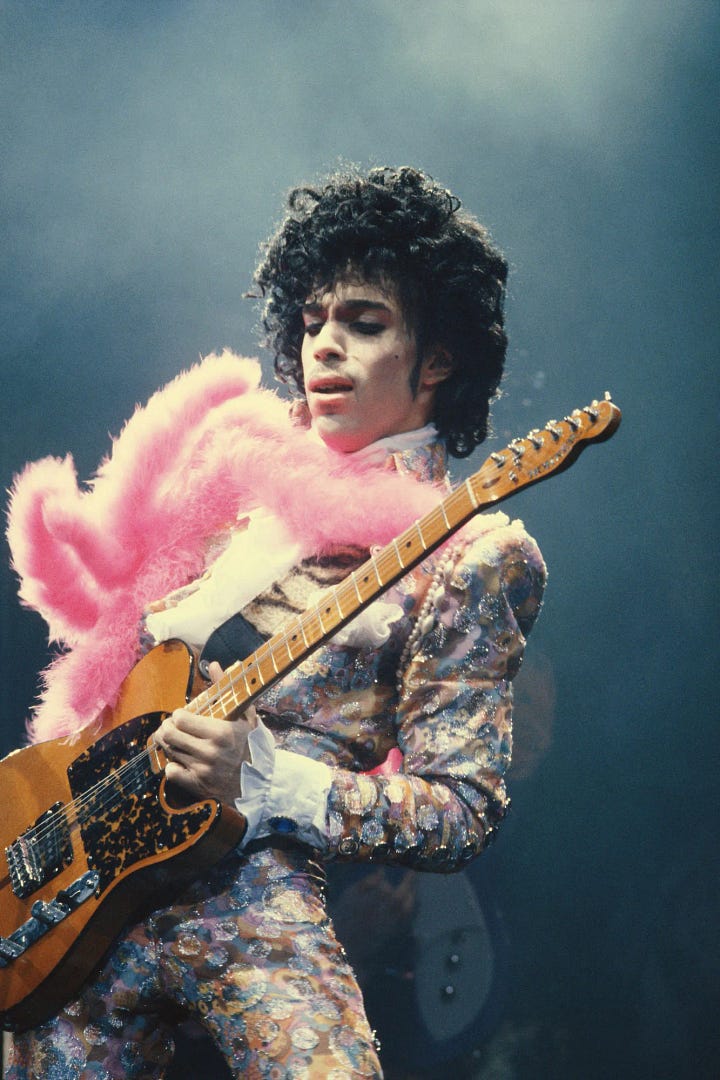
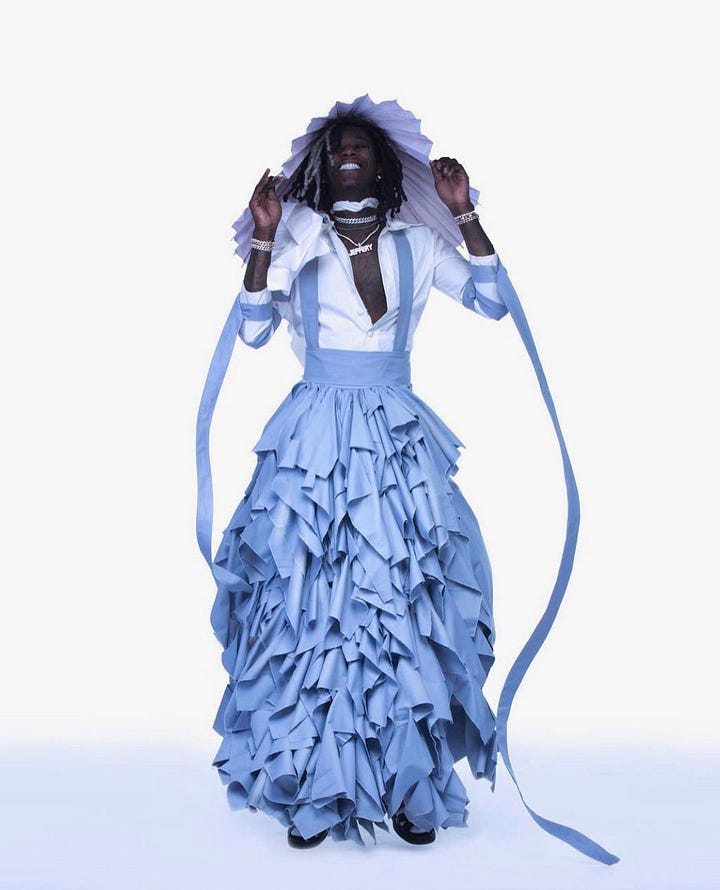
Rema exists within this lineage. Like Prince, he understands that masculinity isn’t just about dominance, it’s about presence. Like Young Thug, he sees fashion as an extension of self-expression, not a constraint. Yet, what makes Rema’s approach unique is that he’s doing this in Afrobeats, a genre that has largely leaned into traditional markers of masculinity, and while he keeps up the performance in his lyrics, his image leans more into the soft and feminine—for now.
If this tells me anything, it’s that Rema’s dynamism as an artist doesn’t have time constraints. He might lean ever so slightly into the feminine now, but change it altogether in a few months. What’s so refreshing about this is that this in itself is artistry, the continued progression of expression as one’s state of mind changes. This makes him feel more authentic than most artists. Fans aren’t just watching him change his look for the sake of a new album rollout; they’re watching him grow. And because of that, his branding never feels forced; it feels natural. That alone makes Rema an artist to watch a little more closely.






